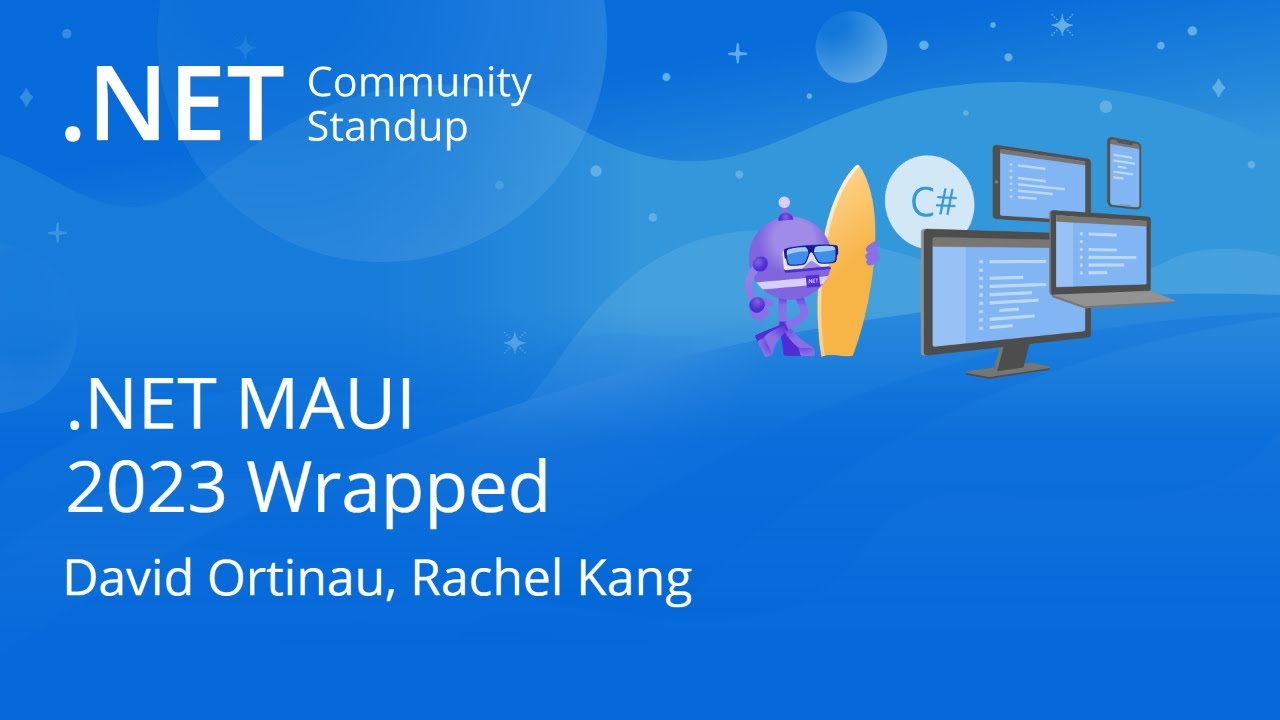Sands of MAUI: Issue #128

Welcome to the Sands of MAUI—newsletter-style issues dedicated to bringing together latest .NET MAUI content relevant to developers.
A particle of sand—tiny and innocuous. But put a lot of sand particles together and we have something big—a force to reckon with. It is the smallest grains of sand that often add up to form massive beaches, dunes and deserts.
.NET developers are excited with the reality of .NET Multi-platform App UI (.NET MAUI)—the evolution of modern .NET cross-platform developer technology stack. With stable tooling and a rich ecosystem, .NET MAUI empowers developers to build native cross-platform apps for mobile/desktop from single shared codebase, while inviting web technologies in the mix.
While it may take a long flight to reach the sands of MAUI island, developer excitement around .NET MAUI is quite palpable with all the created content. Like the grains of sand, every piece of news/article/documentation/video/tutorial/livestream contributes towards developer experiences in .NET MAUI and we grow a community/ecosystem willing to learn and help.
Sands of MAUI is a humble attempt to collect all the .NET MAUI awesomeness in one place. Here's what is noteworthy for the week of December 18, 2023:
.NET MAUI Community Standup
Developer excitement is palpable with .NET MAUI—the evolution of cross-platform .NET development stack reaching mobile/desktop from a shared codebase. The .NET MAUI team hosts monthly Community Standup livestreams to celebrate all things .NET MAUI and provide updates—a wonderful way to bring the developer community together.
David Ortinau and Rachel Kang hosted the latest standup, with a seasonal elf aka special guest Shane Neuville—the December .NET MAUI Community Standup was fun.
Given the end of the year, it was time to look back at all the momentum .NET MAUI has enjoyed in 2023—there were lots of Preview, Service and GA releases. The health of any open source project is evident from contributions—there was a lot of work put in by the core .NET MAUI engineering team and community members alike. The trio wrapped up all the .NET MAUI updates and notable content created, thanked top contributors and discussed what lay ahead for .NET MAUI in 2024.
Overall, the December .NET MAUI Community Standup was a great way to celebrate all the progress made as the year comes to a close, with an eye out for the future—cheers.

.NET MAUI Navigation UI
Content is key for any app, but organization of content can often be challenging—this is particularly true for native cross-platform apps built with .NET MAUI that runs of various form factors. Content needs to be readily discoverable with easy navigation from top level and UI paradigms need to be consistent, yet catering appropriate UX based on device screen size.
Thankfully, there is UI help for .NET MAUI developers and Rossitza Fakalieva wrote up a post—achieve adaptive layout in a cross-platform apps with Telerik UI for .NET MAUI NavigationView.
Progress Telerik UI for .NET MAUI continues to be the most comprehensive UI component suite for all .NET MAUI apps—native performant UI controls that work seamlessly across platforms. Hamburger menu, Drawer UI or NavigationView—whatever it is called, the UI paradigm is well understood and provides content organization with easy top-level navigation. UX differs per device form factor, from a hamburger button on phones, compact menu on tablets or fully expanded sidebar on desktop.
Rossi walks through the various nuances of the Telerik UI for .NET MAUI NavigationView—display modes, customizable header/footer, events/command support and rich styling APIs. With easy-to-follow code samples, the Telerik UI for .NET MAUI NavigationView difference is obvious—developers are always in control in configuring adaptive navigation UI for .NET MAUI apps targeting various platforms/devices. Simplicity of user experience with developer flexibility—sounds like a win-win.

.NET Conf Recap
.NET MAUI is the evolution of modern .NET cross-platform development stack, allowing developers to reach mobile and desktop form factors from a single shared codebase. While .NET MAUI started with .NET 6 runtime, the framework and associated tooling hit adolescence with .NET 7 and is all matured with .NET 8. The usual team of David Ortinau and Maddy Montaquila took the stage at the recently concluded .NET Conf, and Leomaris Reyes wrote up a wonderful recap article—what's new with .NET MAUI in .NET 8.
The dominant theme of .NET MAUI work in .NET 8 is quality—increased stability can be seen everywhere from framework to platform implementations, all with better performance and tooling support. David and Maddy started off with developer adoption and the momentum .NET MAUI has been enjoying—the sheer number of issues closed and community pull requests in the .NET 8 release is something to be proud of.
The duo talked through all the enhancements in .NET MAUI for .NET 8, like better memory management, desktop keyboard support improvements, UI control functionality and enabling Blazor/MAUI Hybrid apps—all contributing towards developer flexibility and confidence.
With real-world showcase of modern developer experience in Visual Studio/VS Code, the .NET MAUI message should be clear—modern .NET cross-platform development stack is mature and welcoming to all.

.NET MAUI with DevOps
The next big milestone for .NET is here with .NET 8 carrying the LTS badge—the latest .NET 8 release empowers millions of apps across the web, mobile, desktop, gaming, IoT and more. Developers can take advantage of latest framework updates, performance tuning, expressive programming languages, mature tooling and rich ecosystems—it's a good time to be a .NET developer.
The annual .NET release also coincided with the biggest .NET developer virtual event of the year—.NET Conf was scheduled for November 14-16. David Ortinau and Sweekriti Satpathy got together to host a wonderful session at .NET Conf—building .NET MAUI apps with DevOps.
Building native cross-platform mobile/desktop apps is intrinsically complex. And the real challenges often begin after the app has been developed and is ready to ship. Developers working on their own or as a part of a team want flexibility of how a .NET MAUI app is built, tested, bundled and published. DevOps can help—Sweeky showed off various tips for optimized workflows with GitHub Actions and Azure DevOps. For developers building streamlined pipelines for .NET MAUI app build/delivery, modern .NET CLI and YAML can help—Sweeky started with the basics and showed off environment setup in GitHub Actions, Azure DevOps or self-hosted options.
Signing and publication/distribution of .NET MAUI apps can also be tricky—there is quite a bit of help with generated artifacts in a properly configured pipeline. With easy-to-follow examples, Sweeky showcased that a little bit of effort in DevOps goes a long way towards the success of .NET MAUI mobile/desktop apps - here's to developer success.

.NET MAUI Publish Tool
Visual Studio Code is the uber-popular lightweight code editor that works seamlessly across Windows/macOS/Linux. With .NET continuing to be inviting to everyone without a barrier to entry, VS Code is the perfect lightweight code editor to get started with cross-platform app development with .NET.
VS Code is now the preferred cross-platform editor for many .NET MAUI developers and there is additional help to keep developers productive, as Gerald Versluis pointed out—say hello to the new .NET MAUI Archive/Publish tool.
Shipping apps to iOS/Android/Windows app stores is not for the fainthearted—with each platform having different gated rules, developers often feel the hassle of signing/distributing apps. The new .NET MAUI Archive/Publish tool is a nifty VS Code Extension that aims to ease developer pain in shipping cross-platform apps to various app stores.
The Extension packs a set of essential tools to streamline the process of packaging and publishing .NET MAUI projects—supported platform targets include Android, iOS and Windows. Developers can get help with managing Provisioning Profiles, Keystores, Code Signing keys and more. While still under active development, the new VS Code Extension already has a lot of promise in archiving/publishing .NET MAUI apps.

That's it for now.
We'll see you next week with more awesome content relevant to .NET MAUI.
Cheers, developers!

Sam Basu
Sam Basu is a technologist, author, speaker, Microsoft MVP and gadget lover. With a long developer background, he also worked as a Developer Advocacy Manager for advocating modern web/mobile/cloud development platforms on Microsoft/Telerik/Kendo UI technology stacks. His spare times call for travel, fast cars, cricket and culinary adventures with the family.

